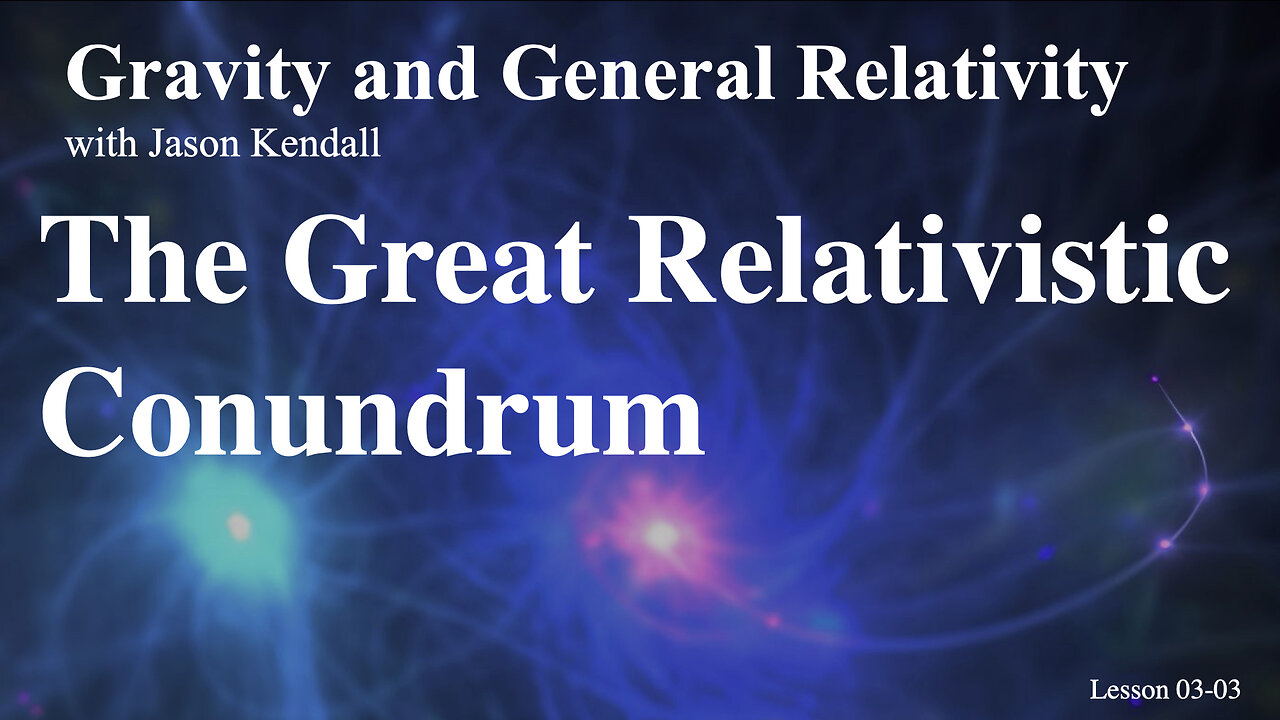Premium Only Content

The Quest for Light: From AEther to Relativity
In this lecture, we delve into the fascinating history surrounding the discovery of light and its implications for our understanding of the universe. While our exploration may initially seem detached from astronomy, it is critical to recognize that light serves as our primary means of gathering information from celestial objects. With the Moon approximately 200,000 miles away, the Sun about 93 million miles distant, and stars measured in light-years, understanding how light operates is essential for interpreting the cosmos. Our inquiry begins with the Michelson-Morley experiment, which aimed to identify the medium through which light travels. This experiment serves as a pivotal moment in the history of physics, leading to the development of special relativity and general relativity. To fully appreciate its significance, we must first revisit the foundational ideas of Sir Isaac Newton. Isaac Newton’s mechanics were predicated on the concepts of absolute space and absolute time. In Newtonian mechanics, time is viewed as a universal clock that uniformly progresses throughout the cosmos, independent of any observer. This perspective posits that time moves steadily, second by second, and is the same for everyone. Similarly, Newton proposed that space is an absolute framework within which objects move, allowing for movement in all directions—left, right, forward, and backward. In this context, Newton also introduced the concept of inertia, which describes the resistance to acceleration experienced by objects. For example, he illustrated this concept through the rotation of water in a bucket. When the bucket is rotated, the water moves outward toward the bucket’s edge due to its inertia, thereby demonstrating its behavior in relation to absolute space. The implication of Newtonian mechanics is that simultaneous events—those occurring at the same time but separated by distance—are governed by absolute time. This allows for a coherent understanding of events in different locations. For instance, two individuals observing a celestial event simultaneously would be experiencing a shared moment in absolute time, regardless of their distance apart. However, as we explore further, we encounter a paradox. While Newton’s framework provides a solid understanding of motion and gravity, it struggles to reconcile with the emerging understanding of light. The notion of absolute space and time becomes problematic when considering the propagation of light as a wave. Historically, all wave theories have relied on the existence of a medium—like water for water waves or air for sound waves—through which waves can travel. Thus, it was commonly believed that light must also propagate through a medium. This hypothetical medium was termed the luminiferous ether, a substance thought to permeate the universe and facilitate the transmission of light. The ether was envisioned as an undetectable, immutable force that existed everywhere, providing a fixed reference frame for the propagation of light waves. As the Earth moved through this ether, scientists believed they could measure the speed at which light traversed the medium. To investigate the existence of the luminiferous ether, Michelson and Morley devised an experiment in 1887 that utilized an interferometer. Their apparatus was designed to split a beam of light into two paths, allowing them to observe the interference patterns created by the recombination of the beams. If the Earth was indeed moving through the luminiferous ether, they expected to detect a phase shift in the interference pattern based on the Earth’s movement relative to the ether. After extensive experimentation, however, Michelson and Morley found no evidence of an ether wind, leading to the conclusion that the speed of light remained constant regardless of the Earth’s motion. This result presented a significant challenge to the ether theory and raised fundamental questions about the nature of light. To better understand the historical context of these discoveries, we must also consider earlier attempts to measure the speed of light. In 1638, Galileo attempted to measure light’s speed using lanterns placed atop distant hills. His efforts yielded inconclusive results, leading him to conclude that light must travel exceedingly fast, possibly even instantaneously. A few decades later, in 1676, Ole Rømer provided a more quantitative estimate of light’s speed by observing the transits of the Galilean moons of Jupiter. He noted variations in the predicted transit times due to the changing distance between Earth and Jupiter as Earth orbited the Sun. Rømer’s calculations indicated that the speed of light was approximately 220,000 kilometers per second. In 1728, James Bradley conducted experiments on stellar aberration, further refining the measurement of the speed of light to about 300,000 kilometers per second. His work demonstrated the effects of Earth’s motion on the observed positions of stars, reinforcing the notion of a finite speed of light. By 1850, Hippolyte Fizeau employed a rotating mirror and a beam of light to measure the speed of light in both air and water. His findings confirmed the rapid propagation of light, while further experiments by Louis Essen and Gordon Smith in the early 20th century established the speed of light at approximately 299,792 kilometers per second. Returning to the Michelson-Morley experiment, the absence of a detectable ether wind suggested that the luminiferous ether could not exist as previously conceived. This pivotal moment prompted Einstein to propose his theory of special relativity in 1905, which eliminated the need for an ether and established that the speed of light is constant in all inertial reference frames. In summary, the exploration of light’s nature has been shaped by a series of key discoveries, from the early attempts to measure its speed to the revelations of the Michelson-Morley experiment. The development of the wave theory of light and the understanding of light as an electromagnetic wave fundamentally transformed our comprehension of the universe, leading to the formulation of special relativity. As we continue to investigate the properties of light, we recognize its significance as our primary means of understanding the cosmos.
-
 1:29:13
1:29:13
Sarah Westall
4 hours agoThe City of London: Infiltration, Intimidation & Centralized Power w/ Mike Harris
29.1K11 -
 10:14:18
10:14:18
Dr Disrespect
15 hours ago🔴LIVE - DR DISRESPECT - ARC RAIDERS - AGAINST ALL DANGER
185K25 -
 32:09
32:09
ThisIsDeLaCruz
1 day ago $1.09 earnedFalling In Reverse: Christian Thompson’s Stage Tech Revealed
25.4K4 -
 LIVE
LIVE
SynthTrax & DJ Cheezus Livestreams
1 day agoFriday Night Synthwave 80s 90s Electronica and more DJ MIX Livestream 80s Night / Late Night Nostalgia
392 watching -
 4:05:52
4:05:52
Nerdrotic
10 hours ago $13.10 earnedHollywood REGRET | Disney's Predator | The Feminist Avengers - Friday Night Tights 379
61.7K17 -
 2:36:22
2:36:22
Mally_Mouse
4 days agoFriend Friday!! 🎉 - Let's Play! - MIMESIS
29.6K3 -
 41:20
41:20
MattMorseTV
6 hours ago $23.01 earned🔴Schumer just BACKSTABBED his OWN VOTERS. 🔴
37.2K76 -
 3:33:34
3:33:34
MissesMaam
7 hours ago*Spicy* Friend Friday with Mally_Mouse!! 💚✨
13.4K3 -
 57:44
57:44
Candace Show Podcast
6 hours agoBen Shapiro Is Crying Again. | Candace Ep 261
63.8K230 -
 4:13:24
4:13:24
megimu32
6 hours agoOFF THE SUBJECT: MEMESIS w/ MALLY MOUSE | MISSES MAAM | SAVAGEJAYGATSBY
6.82K2